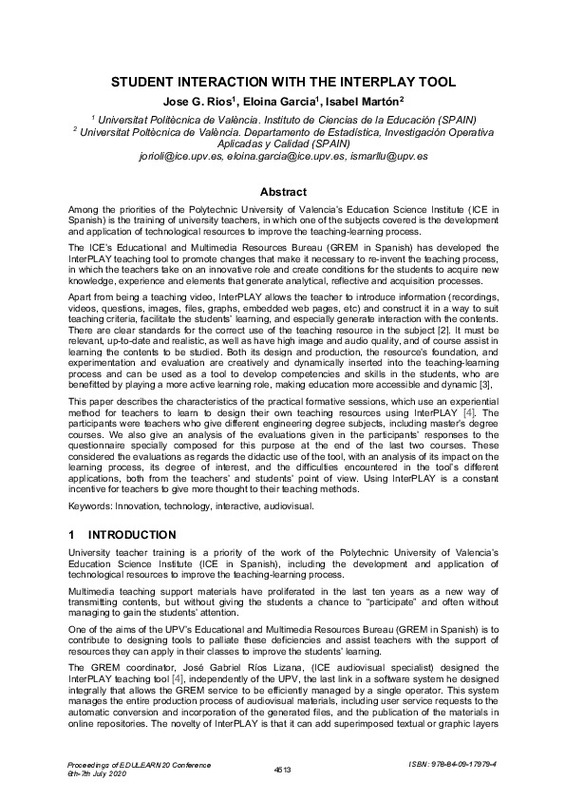|
Resumen:
|
[EN] Among the priorities of the Polytechnic University of Valencia¿s Education Science Institute (ICE in
Spanish) is the training of university teachers, in which one of the subjects covered is the development
and application ...[+]
[EN] Among the priorities of the Polytechnic University of Valencia¿s Education Science Institute (ICE in
Spanish) is the training of university teachers, in which one of the subjects covered is the development
and application of technological resources to improve the teaching-learning process.
The ICE¿s Educational and Multimedia Resources Bureau (GREM in Spanish) has developed the
InterPLAY teaching tool to promote changes that make it necessary to re-invent the teaching process,
in which the teachers take on an innovative role and create conditions for the students to acquire new
knowledge, experience and elements that generate analytical, reflective and acquisition processes.
Apart from being a teaching video, InterPLAY allows the teacher to introduce information (recordings,
videos, questions, images, files, graphs, embedded web pages, etc) and construct it in a way to suit
teaching criteria, facilitate the students¿ learning, and especially generate interaction with the contents.
There are clear standards for the correct use of the teaching resource in the subject [2]. It must be
relevant, up-to-date and realistic, as well as have high image and audio quality, and of course assist in
learning the contents to be studied. Both its design and production, the resource¿s foundation, and
experimentation and evaluation are creatively and dynamically inserted into the teaching-learning
process and can be used as a tool to develop competencies and skills in the students, who are
benefitted by playing a more active learning role, making education more accessible and dynamic [3],
This paper describes the characteristics of the practical formative sessions, which use an experiential
method for teachers to learn to design their own teaching resources using InterPLAY [4]. The
participants were teachers who give different engineering degree subjects, including master¿s degree
courses. We also give an analysis of the evaluations given in the participants¿ responses to the
questionnaire specially composed for this purpose at the end of the last two courses. These
considered the evaluations as regards the didactic use of the tool, with an analysis of its impact on the
learning process, its degree of interest, and the difficulties encountered in the tool¿s different
applications, both from the teachers¿ and students¿ point of view. Using InterPLAY is a constant
incentive for teachers to give more thought to their teaching methods.
[-]
|









